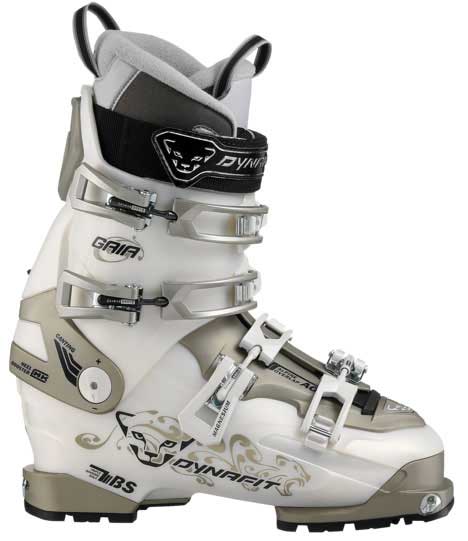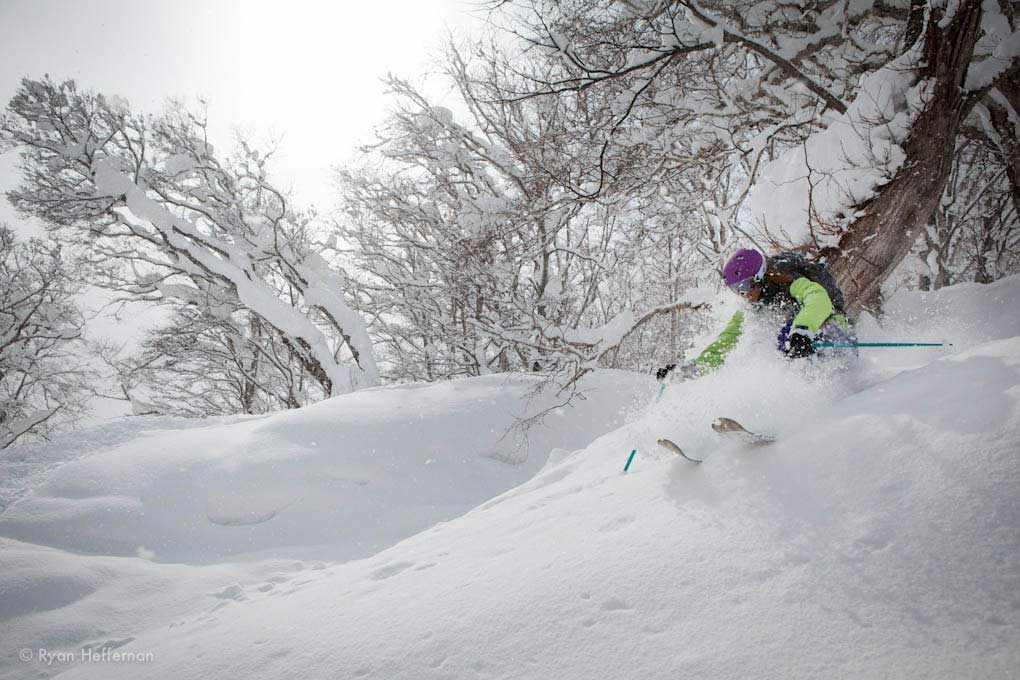 Boots: 2011-2012 Dynafit Gaia TF-X Alpine Touring Boot
Boots: 2011-2012 Dynafit Gaia TF-X Alpine Touring Boot
Skier: 5’6”, 125 lbs, former racer, aggressive and dynamic skier
Foot: size 8 street shoe
Available Sizes: 22.5 – 27.5
Length: 282mm (size 24.5)
Flex: 120
Last: 102
Weight: 1,800 grams / 3.97 lbs (size 25.5)
Liner: Dynafit TF-X Liner
Testing Location: Niseko, Japan; Alta Ski Area; Summit County, Colorado
Days Skied: 20+
After spending three painful days touring in my race boots (which resulted in quarter-sized blisters on both my heels), I decided it was time to explore more comfortable options for my backcountry adventures. Ideally I wanted a boot that could satisfy my aggressive skiing style inbounds, but also allow me to skin long distances with ease. I knew Alpine Touring (or AT) boots had been rapidly gaining popularity in the past few years, so some companies must be offering such a boot for advanced-to-expert women.
I have skied in race boots my entire life, and though I was looking for something more touring oriented, I wasn’t sure how much downhill performance I would be willing to sacrifice. I was hoping to find a boot that could function as a “one-boot quiver,” so my challenge was to determine exactly which of those qualities I valued most in a boot.
I was pleased to find several boots that met my touring/performance requirements, though the Dynafit Gaia looked like an ideal choice with its promise of the “world’s best balance of downhill performance and uphill touring comfort.”
The Gaia felt comfortable out of the box, though admittedly a little too snug. I was used to a toe-crushing race fit so had requested a smaller size, though I think just a little extra room would have been more pleasant without sacrificing too much performance. With a little boot work, though, I was able to make just enough room for my toes.
The Gaia fit my foot anatomy with minimal modifications, which is something I’ve actually found to be more important than simply finding the stiffest boot. (I had originally been looking at men’s boots.) Not only did the fit feel right on my foot, the cuff rested slightly lower to accommodate a woman’s calf.
With just a few more minor adjustments to the Gaia, I felt completely satisfied. I replaced the somewhat flimsy power strap with a Booster Strap, which adds snap to the turn and allows for a more fluid flex. I also inserted custom footbeds, which is something that we at BLISTER always recommend to every skier. The stock liner worked well, but was a little thick (as AT boot liners tend to be), so if you prefer more of a race fit, you might consider a thinner, custom liner (and if you go on longer tours, I’ll say a prayer for your poor feet).
The Gaia is considered stiff for a woman’s boot, but I still had some reservations. Few boots can boast a stiffness comparable to a race boot, and I was curious to see how the supposed 120 flex of the Gaia would compare to that of my Rossignol Radical World Cups. As expected, the Rossi’s flexed stiffer, but I was surprised when the Gaia didn’t just fold up either. And when I tightened the buckles and Booster Strap, I was quite impressed how stiff they felt.
While the Gaia maintained a sturdy flex, they were also incredibly light. The specific type of plastic, liner, and magnesium buckles all contribute to a solid-but-lightweight boot—something I greatly appreciated while touring. The Gaia’s walk mode is also very easy to access, with the quick flip of a lever on the back cuff. And with exchangeable soles compatible with three types of bindings, the Gaia makes it easy to switch between ISO alpine, ISO touring, and Dynafit Quick-Step-in bindings.
So with all the boot’s features dialed and a comfortable fit achieved, how did it actually ski?

My first day on the Gaia was a cold one in Niseko, Japan, last February. As I tried to stay warm making quick turns through the trees off the Center 4 chair at Grand Hirafu, the Gaia felt considerably stiffer than I had previously thought. Of course, most boots will feel stiffer in the cold, and I had added a Booster strap, but I was actually struggling. While I could still flex the boot and dig into the turn, it didn’t have a lively response when I pressured. It was also difficult for me to stay forward over the boot, and kept getting pushed back. At the end of the day I was frustrated, but also knew I wouldn’t be skiing choppy snow and bumps through tight trees in the frigid cold every day. So I gave them another shot.
